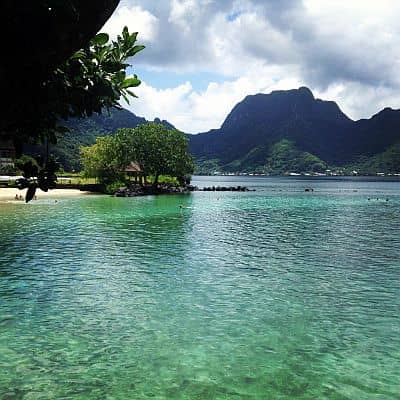Select units of measurement for the temperature and rainfall tables (metric or imperial).
Average weather, temperature, rainfall, sunshine
In American Samoa, the climate is
equatorial, i.e. hot, humid and rainy throughout the year. However, there is a maximum in rainfall from December to March, and a relative minimum from June to September.
American Samoa is an archipelago in the Pacific Ocean south of the equator, and an unincorporated territory of the United States.
Temperatures are stable, with little variations between the hottest period (December to April) and the coolest (June to August). The south-east
trade winds blow steadily throughout the year, especially from May to October, and are stronger during the day, making the heat more bearable.
The
rains are abundant. Typically, they occur in the form of downpours or thunderstorms, which are usually intense but don't last long, in fact, the sun shines quite frequently and regularly, even in the rainiest months. From December to March, however, the rains can sometimes last for the whole day.
Rainfall is enhanced by the
elevations that are found on the volcanic islands (Tutuila, Ta'u, Ofu, and Olosega), which are therefore wetter, while the small islands and the flat atolls (Aunu'u, Swains, and Rose) receive less rainfall, about 2,500 millimeters (100 inches) per year.
On the volcanic islands, the amount of rainfall varies depending on
slope exposure, in fact, it is around 3,000 mm (120 in) per year along the sheltered coasts and around 4,000 mm (160 in) on the coasts exposed to the trade winds; in hilly and mountainous areas, it can even exceed 5,000 mm (200 in) per year.
The climate in detail
Temperature and rain
Pago Pago

In
Pago Pago, the capital, located at 14 degrees south latitude, on the north side of the main island, Tutuila, the average daily temperature ranges from 28.5 °C (83.3 °F) in March to 27.2 °C (80.9 °F) in July and August.
The temperature almost never drops below 20 °C (68 °F): the last time was in July 2014, when it dropped to 19 °C (66 °F).
On the hottest days, the temperature typically reaches 33 °C (961.5 °F) from January to March, however, in El Niño periods, it can reach 35 °C (95 °F), as happened in the first months of 1998 and in February 2016.
In Pago Pago, 3,250 mm (128 in) of rain fall per year, with a maximum of more than 350 mm (13.8 in) from December to February and a minimum of less than 200 mm (8 in) between June and August.
The sun does not shine very often, just 1,850 hours a year. The sunniest months are March and September.

Sea temperature
The sea in American Samoa is warm enough to swim in all year round, in fact the water temperature ranges from 27.5 °C (81.5 °F) in August and September, to 29.5 °C (85 °F) in March and April.
Tropical cyclones
American Samoa is exposed to the
tropical cyclones of the South Pacific. Cyclones are usually formed from November to mid-May, though they are most likely from late December to early April. Outside of this period, there has been cyclone Keli, in June 1997.
When to go
The best time to travel to American Samoa runs from
June to September, since it is the least hot and the least rainy period of the year; anyway, even during this period, downpours and thunderstorms must be put into account.
What to pack
All year round, bring tropics-friendly, loose-fitting clothing, a sun hat, a scarf for the breeze, a light sweatshirt for the evening, and a light raincoat or umbrella.
Climate data - American Samoa
| Pago Pago |
|---|
|
| Jan | Feb | Mar | Apr | May | Jun | Jul | Aug | Sep | Oct | Nov | Dec |
|---|
| Min temp. | 26 | 26 | 26 | 26 | 26 | 25 | 25 | 25 | 25 | 25 | 26 | 26 |
|---|
| Max temp. | 31 | 31 | 31 | 31 | 30 | 30 | 29 | 29 | 30 | 30 | 31 | 31 |
|---|
| Precip. | 385 | 350 | 280 | 285 | 300 | 160 | 190 | 175 | 205 | 260 | 305 | 365 |
|---|
| Prec. days | 21 | 18 | 20 | 18 | 17 | 14 | 16 | 15 | 15 | 17 | 18 | 20 |
|---|
| Humidity | 81% | 82% | 82% | 83% | 83% | 81% | 81% | 81% | 81% | 82% | 82% | 82% |
|---|
| Day length | 13 | 12 | 12 | 12 | 11 | 11 | 11 | 12 | 12 | 12 | 13 | 13 |
|---|
| Sun hours | 5 | 5 | 6 | 4 | 4 | 4 | 5 | 5 | 7 | 5 | 5 | 5 |
|---|
| Sea temp | 29 | 29 | 29 | 29 | 29 | 28 | 28 | 28 | 28 | 28 | 29 | 29 |
|---|